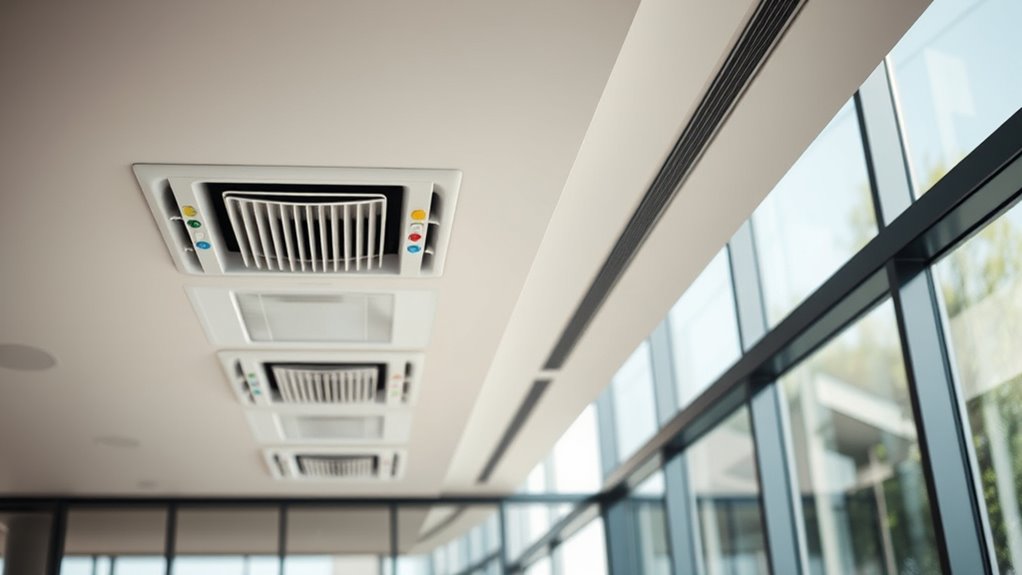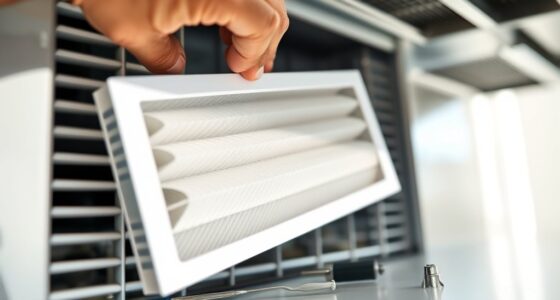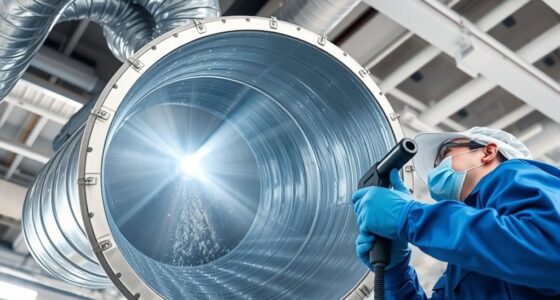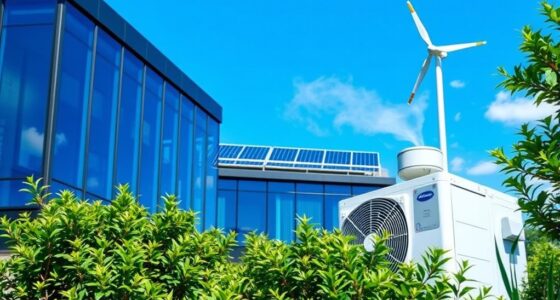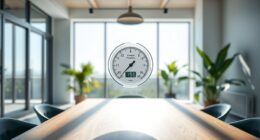To optimize your ventilation system, you should rely on accurate sensors that measure occupancy, CO₂, humidity, and temperature. When these sensors are properly calibrated, they provide precise data to adjust airflow in real-time, ensuring good indoor air quality and energy efficiency. Ignoring calibration risks false readings, which can lead to wasted energy or poor air quality. Keep sensor maintenance in mind, and you’ll discover how smart control improves your environment with greater efficiency.
Key Takeaways
- Dynamic ventilation adjusts airflow in real-time based on occupancy levels detected by sensors.
- Accurate sensor calibration ensures reliable data for effective ventilation control.
- Sensors monitor parameters like CO₂, humidity, and temperature to determine optimal airflow needs.
- Proper maintenance of sensors prevents drift, maintaining system responsiveness and indoor air quality.
- Real-time adjustments optimize energy efficiency while maintaining healthy indoor environmental conditions.

Dynamic ventilation control adjusts airflow in real-time to match the changing needs of a space, guaranteeing ideal indoor air quality and energy efficiency. When you implement this system, you’re actively managing how fresh air circulates, responding instantly to occupancy levels and environmental conditions. The core of this technology relies on sensors that monitor various parameters, like CO₂ levels, humidity, or temperature, to determine when and how much ventilation is necessary. Proper sensor calibration is essential here; if sensors aren’t accurately calibrated, your system might misjudge air quality, leading to either over-ventilation—wasting energy—or under-ventilation, which could compromise indoor air quality.
You need to guarantee that sensors are regularly calibrated to reflect true environmental conditions. This calibration process involves adjusting sensor readings to match known standards, which helps your ventilation system respond correctly. When sensors are off, the system might think a space is cleaner than it actually is or vice versa, resulting in inefficient operation. For example, an uncalibrated CO₂ sensor could signal high levels when they’re not actually present, causing your system to run unnecessarily, wasting energy. Conversely, if the sensor underreports CO₂, you risk poor air quality, which can affect occupants’ health and comfort. Regular calibration ensures your sensors deliver accurate data, enabling your ventilation system to make informed adjustments.
Additionally, studies show that sensor accuracy directly impacts the effectiveness of home security systems, underscoring the importance of precise measurements in maintaining safety and efficiency. By relying on precise sensor data, your system dynamically modulates airflow based on occupancy. When a room is crowded, the sensors detect increased CO₂ or humidity, prompting the system to boost ventilation. As people leave and occupancy drops, the sensors pick up the change, and airflow is reduced accordingly. This real-time adjustment helps maintain ideal indoor air quality without excessive energy consumption. You don’t have to run ventilation at full capacity all the time; instead, it adapts seamlessly to actual needs, saving energy and reducing costs.
Moreover, sensor calibration isn’t a one-time task. Over time, sensors can drift due to environmental factors or aging, leading to inaccurate readings. Regular maintenance, including recalibration, keeps the system functioning accurately. Some advanced systems incorporate self-calibration features, but manual calibration remains the gold standard for ensuring precise control. When you keep sensors properly calibrated, you can trust that your dynamic ventilation system responds correctly, maintaining a healthy indoor environment while optimizing energy use. In the end, this balance between air quality and efficiency hinges on the accuracy of your sensors and the responsiveness of your control system.
Frequently Asked Questions
How Does Occupancy Detection Improve Ventilation Efficiency?
Occupancy detection improves ventilation efficiency by adjusting airflow based on how many people are present, ensuring you get better air quality when needed and saving energy when spaces are empty. With sensors, you prevent over-ventilating, reducing energy consumption and costs. This smart control keeps air fresh and clean, creating a healthier environment while optimizing energy savings, so you enjoy comfort and efficiency in your space.
What Types of Sensors Are Used in Dynamic Ventilation Systems?
You use various sensors like motion detectors, CO2 sensors, and temperature sensors in dynamic ventilation systems. These sensors need regular calibration to guarantee accuracy, and data privacy is vital to protect occupant information. Proper calibration prevents false readings, optimizing airflow and energy efficiency. By safeguarding data privacy, you ensure occupants trust the system while maintaining effective ventilation based on real-time occupancy and environmental conditions.
Can These Systems Integrate With Existing Building Management Systems?
Yes, these systems can seamlessly integrate with your existing building management system, making your smart building more efficient. They communicate through standard protocols, ensuring smooth data exchange. This integration enhances energy savings by optimizing ventilation based on real-time occupancy and sensor inputs. You get a smarter, more responsive environment, reducing costs and improving indoor air quality. Embrace this technology to upgrade your building’s performance effortlessly and sustainably.
What Are the Cost Implications of Implementing Dynamic Ventilation Control?
Implementing dynamic ventilation control can lead to significant energy savings, but you’ll face initial installation costs. These costs depend on your building’s size and existing systems, yet the long-term savings often outweigh the upfront investment. You might also save on operational expenses over time. While the setup can be pricey initially, the energy efficiency benefits make it a smart choice for reducing ongoing costs and improving indoor air quality.
How Does Sensor Accuracy Affect Overall Ventilation Performance?
Sensor accuracy markedly shapes your ventilation’s success. If sensors are precisely calibrated, data reliability increases, leading to smarter, more sustainable ventilation. Conversely, inaccurate sensors cause inconsistent control, compromising comfort and efficiency. Regular calibration ensures sensors deliver dependable data, optimizing airflow and saving energy. When sensors are precise and calibrated, your ventilation system performs perfectly, providing a healthier, happier environment while minimizing waste and costs.
Conclusion
By implementing dynamic ventilation control based on occupancy and sensors, you optimize air quality while conserving energy. Some might worry about system complexity or reliability, but modern sensors and smart algorithms guarantee seamless, accurate operation. This sophisticated approach not only enhances comfort but also reduces costs and environmental impact. So, embracing this technology means you’re making a smart, future-proof choice—balancing efficiency with health, without sacrificing simplicity or dependability.
